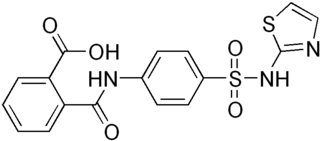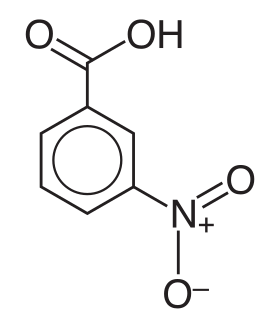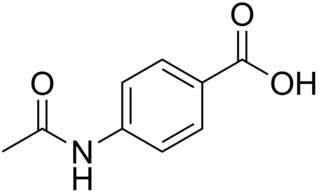This page is based on this
Wikipedia article Text is available under the
CC BY-SA 4.0 license; additional terms may apply.
Images, videos and audio are available under their respective licenses.

Bumetanide is a loop diuretic of the sulfamyl category, most often used to treat heart failure. It is often used in people in whom high doses of furosemide or other diuretics are ineffective. It is marketed by Hoffmann-La Roche. The main difference between bumetanide and furosemide is in their bioavailability and potency. About 60% of furosemide is absorbed in the intestine, and there are substantial inter- and intraindividual differences in bioavailability. About 80% of bumetanide is absorbed, and its absorption does not change when it is taken with food. It is said to be a more predictable diuretic, meaning that the predictable absorption is reflected in a more predictable effect.

Pterin is a heterocyclic compound composed of a pteridine ring system, with a "keto group" and an amino group on positions 4 and 2 respectively. It is structurally related to the parent bicyclic heterocycle called pteridine. Pterins, as a group, are compounds related to pterin with additional substituents. Pterin itself is of no biological significance.

The Misuse of Drugs Act is a drug control law in Singapore classifying substances into three categories, Classes A, B, and C. Section 44 provides that "The Minister may, by an order published in the Gazette" add, remove, or transfer drugs among the classes. The statute's penal provisions are severe by most nations' standards, providing for long terms of imprisonment, caning, and capital punishment. The law creates a presumption of trafficking for certain threshold amounts, e.g. 30 grams of cannabis. It also creates a presumption that a person possesses drugs if he possesses the keys to a premises containing the drugs, and that "Any person found in or escaping from any place or premises which is proved or presumed to be used for the purpose of smoking or administering a controlled drug shall, until the contrary is proved, be presumed to have been smoking or administering a controlled drug in that place or premises." Thus, one runs the risk of arrest for drug use by simply being in the company of drug users. The law also allows officers to search premises and individuals, without a search warrant, if he "reasonably suspects that there is to be found a controlled drug or article liable to seizure". Moreover, Section 31 allows officers to demand urinalysis of suspected drug offenders.

Chorismic acid, more commonly known as its anionic form chorismate, is an important biochemical intermediate in plants and microorganisms. It is a precursor for:

Butamben is a local anesthetic. It is the ester of 4-aminobenzoic acid and butanol.
A white, odourless, crystalline powder. that is mildy soluble in water and soluble in alcohol, ether, chloroform, fixed oils, and dilute acids. It slowly hydrolyses when boiled with water. Synonyms include Butamben, Butilaminobenzoato, and Butoforme. Proprietary names includes Alvogil in Spain and Alvogyl in Switzerland. It is one of three components in the topical anesthetic Cetacaine.

Balsalazide is an anti-inflammatory drug used in the treatment of inflammatory bowel disease. It is sold under the brand names Giazo, Colazal in the US and Colazide in the UK. It is also sold in generic form in the US by several generic manufacturers.

Dihydropteroate is an important intermediate in folate synthesis. It is a pterin created from para-aminobenzoic acid (PABA) by the enzyme dihydropteroate synthase.

Dihydropteroate synthase is an enzyme classified under EC 2.5.1.15. It produces dihydropteroate in bacteria, but it is not expressed in most eukaryotes including humans. This makes it a useful target for sulfonamide antibiotics, which compete with the PABA precursor.

Aminomethylbenzoic acid is an antifibrinolytic.

Phthalylsulfathiazole belongs to the group of drugs called sulfonamides. The drug is a broad-spectrum antimicrobial that can treat different types of infections including intestinal. The mechanism of action depends on competitive antagonism with para-aminobenzoic acid and inhibition of dihydropteroate synthetase activity, which in turn leads to impaired synthesis of dihydrofolic acid and as a result its active metabolite necessary for the synthesis of purine and pyrimidine.

Aminohippuric acid or para-aminohippuric acid (PAH), a derivative of hippuric acid, is a diagnostic agent useful in medical tests involving the kidney used in the measurement of renal plasma flow. It is an amide derivative of the amino acid glycine and para-aminobenzoic acid that is not naturally found in humans; it needs to be IV infused before use diagnostically.
The molecular formula C7H7NO2 (molar mass: 137.14 g/mol) may refer to:

Nitrobenzoic acids are derivatives of benzoic acid. Two are commercially important. They are about ten times more acidic than the parent benzoic acid.

Acedoben (4-acetamidobenzoic acid) is a chemical compound with the molecular formula of C9H9NO3. It is the acetyl derivative of para-aminobenzoic acid (PABA).

4-Fluorobenzoic acid (p-fluorobenzoic acid) is an organic compound with the formula C7H5FO2. This colourless solid is a derivative of benzoic acid carboxylic acid. It is a synthetic intermediate.
Rubrivivax benzoatilyticus is a bacteria that can make use of light or aromatic compounds for growth. It is brown coloured.















